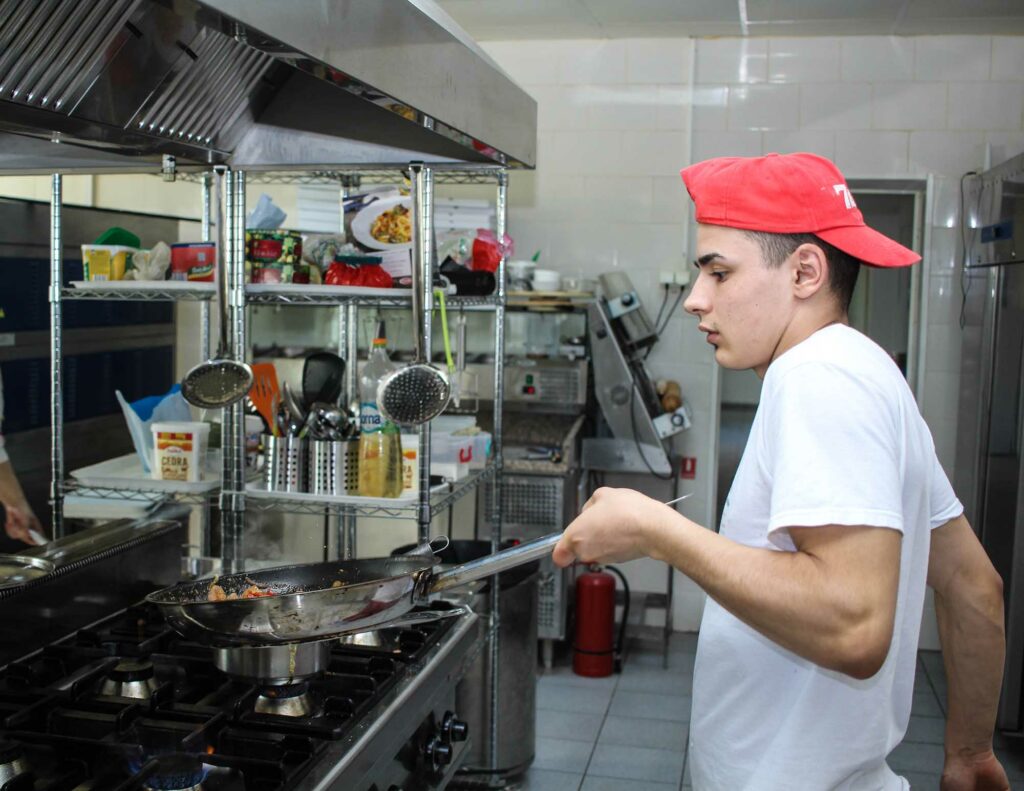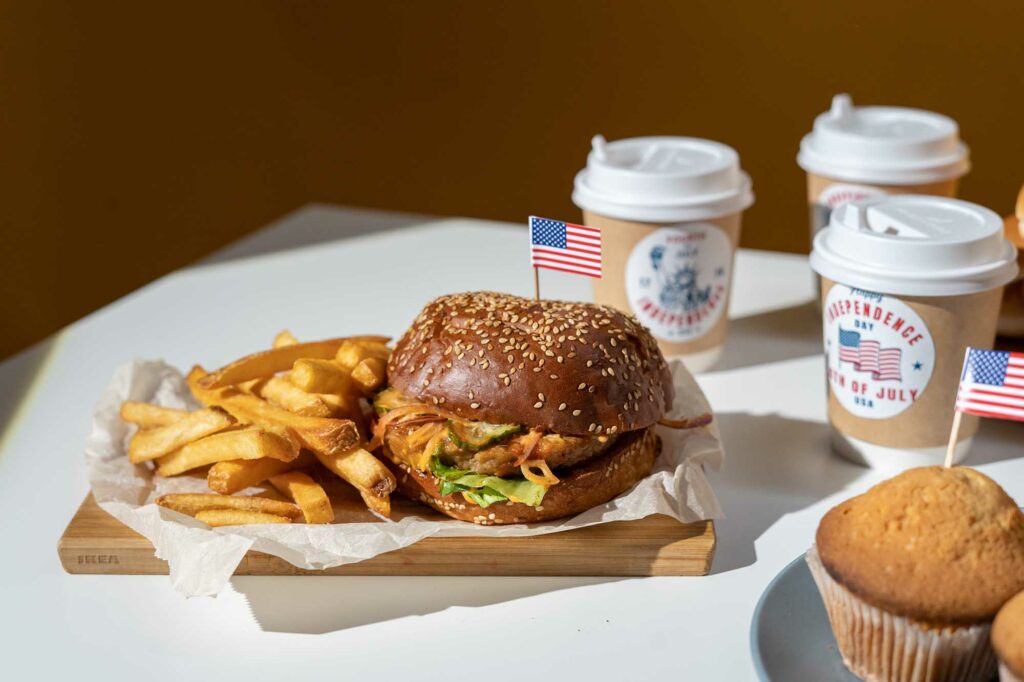This post explores ghost kitchens, as well as virtual kitchens, and how their rising number in the United States could be a growing problem.
Table of Contents
Technology drives many interactions in the modern world, and it’s no different when it comes to eating experiences in 2023. Ghost kitchens offer a new way to market take-out food, though they are unfortunately disguised under manipulative marketing tactics and often provide duplicitous advertising while operating out of big chain restaurants. The many alarming aspects of ghost kitchens make them a rather insidious way to both have food marketed and prepared.
What Is A Ghost Kitchen?
Ghost kitchens are modern concepts for where food is prepared for delivery services. They are also referred to as cloud kitchens or dark kitchens and operate on food delivery services such as GrubHub or Door Dash. That means that there are never sit-down locations for dining. However, these independent food vendors often operate out of existing kitchens, which complicates what is being ordered. Unfortunately, such services appear inconsistent with labeling whether vendors are using ghost kitchens or traditional restaurants for food preparation. That means that many people might purchase food from a ghost kitchen without intending to.
Investigative YouTuber Eddy Burback put the grease work into deep-diving into the world of ghost kitchens. The LA-based content creator broke ghost kitchens down into three main categories. Ghost kitchens tend to occur in either virtual restaurants, mobile trailers, or existing restaurants. Virtual restaurants are food preparation locations that exist solely for take-out orders. Virtual restaurants can service dozens of ghost kitchens at a single location. A second-way food is prepared for ghost kitchens is through mobile trailers. The third and perhaps most insidious form of food preparation for a ghost kitchen is when the food is prepared at an existing restaurant.
What Is An Example Of A Ghost Kitchen?
To make it clearer, you might order take out from the new listing “Pizza Paradise” only to have your order prepared in your local Applebees kitchen. Or, dozens of seemingly new take out spots could be made under the same roof and encompass everything from pizza to sushi to burritos. That means that Pizza Paradise is coming from the same kitchen that provides for Booyah Burrito.
Do Ghost Kitchens Threaten Small Businesses?

Just how enthusiastically have ghost kitchens invaded our markets? Eddy scrolled his local food delivery app and linked a whopping 44 listings to a single location, meaning they are all ghost kitchens operating at a single virtual restaurant. Perhaps even more disturbingly, he located nine separate listings for the same sandwich at the same price point from different restaurants, though they all made the food at the same location. That means nine ghost kitchens operating out of the same virtual restaurant and offering seemingly the same item. The YouTuber ended up picking up and trying all nine sandwiches, which were identically packaged, and unofficially confirmed their identical taste even though nine separate businesses sold these items.
What does that mean for the competition? Well, ghost kitchen owners are giving themselves an exponentially greater opportunity to be noticed by customers. For example, when someone searches for a taco and receives ten listings and nine come from the same location, they have a ninety-percent chance that they will become a customer from this vendor. In turn, that puts pressure on the smaller business to pay more money to be listed higher on the food ordering service so that more customers end up choosing them over the ghost kitchen with all of the listings. But that doesn’t seem like a fair situation to be thrust into. How are smaller businesses meant to compete with such listings?
Are Ghost Kitchens Scamming Customers?
Ghost kitchens affect multiple groups of people in a negative manner. As discussed, they are a threat to humble mom-and-pop businesses, as they obtain far more listings than these restaurants for single items. Even worse is the fact that they are masquerading as a small business rather than admitting to being a well-known chain. For example, let’s say someone wants to order chicken wings. They purposely don’t want to order from Wing Stop and choose a name that sounds like a new, non-chain restaurant. However, thanks to ghost kitchens, there is now a chance that the food is being prepared at Wing Stop anyway.
This process can cause customers to unwittingly support big companies rather than smaller businesses. In addition, it can cause people to end up purchasing items from restaurants that they don’t want to buy from. For example, maybe a consumer does not want to order dinner from Chili’s, so they try somewhere new only to be delivered items cooked at Chili’s but sold under a different name. Is that ethical? Meanwhile, the person who works for GrubHub or DoorDash who is trying to pick up the order is having a very difficult time looking for Booyah Burrito, because it in fact doesn’t exist and is simply being sold out of a Chili’s.
In addition to competition and customers being affected by ghost kitchens, workers also face consequences. Let’s say food is being cooked in a Chili’s for several ghost kitchens. Though Chili’s nets the profit for all of these sales, they are only able to hire staff according to the revenue that Chili’s alone generates. That means that although the business is netting considerable profits, employees are forced to work harder for the same pay and without additional hours when ghost kitchens are operated out of existing businesses.
Are Ghost Kitchens Unhygienic?
At this point, there are numerous reasons why ghost kitchens appear to be a red flag. However, it gets even worse when it comes to health measures. For one, ghost kitchens can operate out of locations that have failed health code violations, since they are servicing a different restaurant than the one which received the violations. This bizarre loophole opens up the possibility for food to be prepared under unsavory conditions.
Meanwhile, the sheer mass of food that is prepared at virtual restaurants due to the number of ghost kitchens can make it difficult to keep track of allergens. This is also an issue when ghost kitchens take place in existing establishments. Perhaps a restaurant has passed a health inspection, but maybe new allergens are being introduced that could threaten the quality of the food for customers with allergies, dietary restrictions, or dietary needs. Since ghost kitchens disguise themselves as real restaurants, they are notoriously hard to track down for health code inspections.
Closing Notes On Ghost Kitchens

While ghost kitchens appear like a flawed concept and certainly don’t seem like they would be able to operate legally in all lands in the same way they have managed to exploit loopholes in the US foodservice system, there are undeniably potential positive aspects of the concept. Ghost kitchens can provide a way for underutilized kitchens in struggling small businesses to find new ways to attract customers and bring in revenue. Therefore, it doesn’t have to be an inherently negative concept.
Unfortunately, however, ghost kitchens appear riddled with too many flaws to be something celebrated. What could assist this concept is more transparency, such as food service apps making it clear every time a listing is a ghost kitchen. Furthermore, there should be more regulations in place so that companies aren’t permitted to offer the same product under multiple listings, as this clearly disadvantages competitors and is duplicitous to customers. Lastly, it is simply unacceptable that these kitchens skirt necessary health code checks, as standards must be met when it comes to food safety, as well as marketing transparency.
In the meantime, consumers should put more research into which restaurants they order from on apps if this topic leaves them feeling concerned. Check if the restaurant has a physical location and investigate how many suspicious new eateries appear to have cropped up on your favorite food delivery platforms.
Continued Reading: Guilt-Free Living Guaranteed
